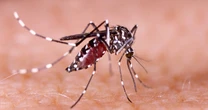Early in the pandemic, researchers at Harvard Medical School and Harvard-affiliated Brigham and Women’s Hospital started trying to develop a new way to block respiratory infections. Now a newly published preclinical study suggests how well their product, a nasal spray, might work. In mice, it was nearly 100% effective at stopping viruses and bacteria from causing infection.
When someone who’s sick coughs or sneezes, they spray out tiny germ-filled droplets that others can breathe in through their nose. The new nasal spray, which coats the inside of the nose, is designed to burst the droplets and capture the pathogen in a strong, gel-like matrix. “That prevents the transport of both viruses and bacteria,” says co-senior author Nitin Joshi, an assistant professor of anesthesiology at Harvard Medical School and associate bioengineer at Brigham and Women’s Hospital. After the germs are captured, they’re neutralized by binding with ingredients in the spray.
In the study, the researchers exposed mice to a dangerous flu virus, giving the animals 25 times the lethal dose. The mice who were administered the spray stayed healthy. The spray, which the researchers call PCANS (pathogen capture and neutralizing spray) also worked against the COVID-19 virus; respiratory syncytial virus, or RSV; adenovirus; and pneumonia-causing bacteria. Though it hasn’t yet been tested on rhinovirus, which causes the common cold, it’s likely to be effective against it as well.
While other nasal sprays exist, they offer only limited protection, blocking between 20% and 70% of pathogens. “Most of these approaches only have one mechanism of action,” Joshi says. “They either block the pathogen entry or they neutralize the pathogen. The other problem was that none of these formulations really paid attention to capturing of the respiratory droplet.” The new formula has three mechanisms of action—bursting droplets, capturing the pathogens, and neutralizing them.
Some other nasal sprays also contain drugs that can have side effects and shouldn’t be used long term. The new product is drug-free. It uses only ingredients from the Food and Drug Administration’s list of inactive ingredients and “GRAS,” or generally recognized as safe, ingredients. That also means it will be easier to get regulatory approval. “The drug-free design was intentional because we really wanted to bring this out to the public as soon as possible,” Joshi says.
The team will now move forward with human studies. Those done with mice suggest that the spray works for nearly eight hours. If it’s as long-lasting in humans, a person could use it once or twice a day when they’re in a crowded place, like at a conference.
It’s actually already possible to try it: A company called Akita Biosciences has licensed the tech and started selling it as a personal-care product, without making any health claims.











No comments